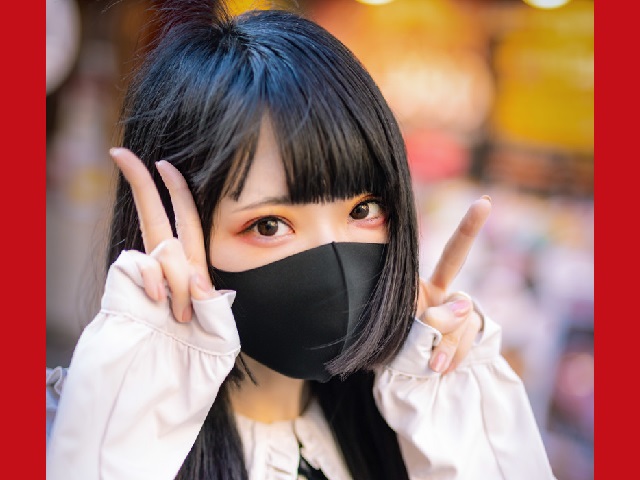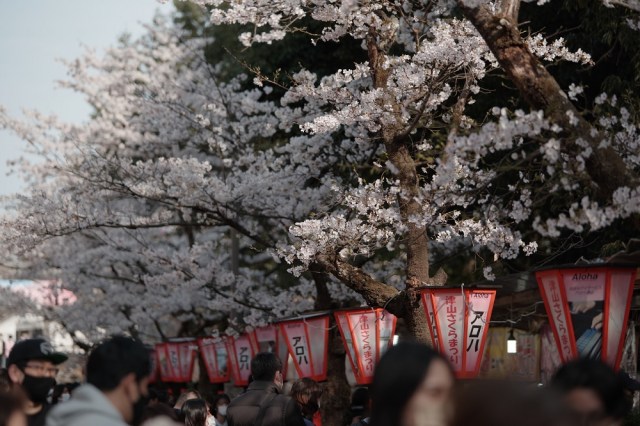
Combination of factors is keeping masks on in Tokyo even as the government says they don’t have to be.
On March 13, Japan’s Ministry of Health, Labor, and Welfare revised its mask recommendations, saying that the wearing of masks as a coronavirus countermeasure will now be “left to personal judgement.” But unlike in some other parts of the world, the lifting of masking recommendations didn’t result in a mass peeling off of face covering and an audible satisfied sigh from the people of Japan.
Instead, our reporters found that little had changed in the days immediately following the relaxed guidelines, as the vast majority of people we saw in Tokyo, both indoors and out, remained masked up while around others, and broadcaster Nippon Television Network had similar observations. Setting up a camera on a busy street outside Tokyo Station on March 13, the network found that 89.7 percent of passersby were masked up.
But one month later, has baseline behavior changed? On April 10 (which, like May 13, was a Monday), Nitele repeated the experiment at the same location, at the same time of day, and the result was…
…pretty much the same. Nearly a month after “follow your personal judgement” became the government’s stance on masks, the vast majority, 85.6 percent, of people were still wearing masks this past Monday.
There are a couple of likely reasons why, starting with the fact that Tokyo is seeing an uptick in its number of new coronavirus infections. On February 27, the city saw 1,028 new infections, but the daily number dipped below 1,000, and stayed down there, all the way until March 26. Since then, though, there have been six more days with over 1,000 new infections, including five in row from April 2 to April 6 (and with 956 on April 7, Tokyo just barely missed having six over-1,000 days in a row).
There’s also the fact that cherry blossom season, which started in late March this year, is really the first significant “get out and go places” occasion in quite some time. Though many travel and event regulations were scaled back last fall, the next major vacation period in Japan wasn’t until New Year’s, which most people celebrate by going back to their hometowns and relaxing at home with family. Cherry blossom season, though, involved a lot more close contact with others at crowded parks and hanami (cherry blossom-viewing) parties, which also means a lot more clustering in famous sakura spots and their associated transportation access points. So with more people moving around, staying masked likely seems like a good idea to many.
Another major factor is that it’s hay fever season in Japan right now. The country’s high concentrations of eminently allergenic pollen had made masking up part of spring for many long before the coronavirus pandemic. With masks already so prevalent at this time of year, you’re not going to look odd at all with one on, and so even people who don’t suffer from hay fever, but are still a little leery about the possibility of coronavirus infection, can remain masked up without feeling self-conscious.
And last, but definitely not least, is that even before the government made their recommendation official on March 13, a lot of the masking that was going on in Japan was already largely a matter of personal judgement. Even during the height of the pandemic, a lot of the masking taking place wasn’t due to legal requirements, but a general sense of “Well, this might be sort of a hassle, but if it helps prevent people getting sick, then I’ll do it.” Being willing to take on a bit of personal inconvenience for the public good is one of Japan’s defining societal values, and complaining about it is a pretty quick way to earn a reputation as selfish and immature. So even as Nitele’s study shows masks becoming slightly less common, they’re still the norm in Japan, and probably will be for a while longer.
Source: Nitele via Livedoor News via Hachima Kiko, Tokyo Metropolitan Government
Top image: Pakutaso
Insert image: Pakutaso
● Want to hear about SoraNews24’s latest articles as soon as they’re published? Follow us on Facebook and Twitter!


 Mask rules in Japan have changed…so are people still wearing them?
Mask rules in Japan have changed…so are people still wearing them? Masks should still be worn indoors, majority of Japanese people in poll say
Masks should still be worn indoors, majority of Japanese people in poll say Japanese government enacts mask resale ban, sets prison time penalty for violators
Japanese government enacts mask resale ban, sets prison time penalty for violators No mask, no ride – Japanese government allows taxis to refuse to pick up maskless passengers
No mask, no ride – Japanese government allows taxis to refuse to pick up maskless passengers Japanese airline leaves passenger behind at rural island airport after he refuses to wear mask
Japanese airline leaves passenger behind at rural island airport after he refuses to wear mask That time Seiji called JASRAC to ask why he didn’t get paid royalties for his song being on TV
That time Seiji called JASRAC to ask why he didn’t get paid royalties for his song being on TV The best Starbucks Japan Frappuccinos we want to drink again in 2026
The best Starbucks Japan Frappuccinos we want to drink again in 2026 Osaka hotel has amazing all-you-can-eat takoyaki and kushikatsu breakfast buffet
Osaka hotel has amazing all-you-can-eat takoyaki and kushikatsu breakfast buffet 7 great places to see Mt. Fuji from without having to climb it
7 great places to see Mt. Fuji from without having to climb it New Japanese menstrual product seeks to help women spot unidentified iron deficiencies
New Japanese menstrual product seeks to help women spot unidentified iron deficiencies Mikado Coffee is a 76-year-old coffee chain with a major celebrity connection
Mikado Coffee is a 76-year-old coffee chain with a major celebrity connection Shiratani Unsuikyo: The breathtaking anime setting where Princess Mononoke was born
Shiratani Unsuikyo: The breathtaking anime setting where Princess Mononoke was born 7-Eleven Japan’s ramen-cooking robot whipped us up a bowl of noodles【Taste test】
7-Eleven Japan’s ramen-cooking robot whipped us up a bowl of noodles【Taste test】 Why is there a wrestling ring in the Underground Arena fighting bar in Kabukicho?
Why is there a wrestling ring in the Underground Arena fighting bar in Kabukicho? Harajuku’s new permanent Tamagotchi shop is filled with cuteness and a surprising lack of poop
Harajuku’s new permanent Tamagotchi shop is filled with cuteness and a surprising lack of poop Starbucks Japan ready to get Year of the Horse started with adorable drinkware and plushies【Pics】
Starbucks Japan ready to get Year of the Horse started with adorable drinkware and plushies【Pics】 Cyberpunk anime meets traditional culture in Ghost in the Shell gold leaf Japanese changing screens
Cyberpunk anime meets traditional culture in Ghost in the Shell gold leaf Japanese changing screens Hello Kitty Choco Egg figures are an adorable trip through three periods of Japanese pop culture【Pics】
Hello Kitty Choco Egg figures are an adorable trip through three periods of Japanese pop culture【Pics】 We found possibly the quietest Japanese-style hotel in Tokyo’s bustling Shinjuku district
We found possibly the quietest Japanese-style hotel in Tokyo’s bustling Shinjuku district Japan’s otoshidama tradition of giving kids money at New Year’s gets a social welfare upgrade
Japan’s otoshidama tradition of giving kids money at New Year’s gets a social welfare upgrade Sumo Sanrio! Hello Kitty and pals team up with Japan Sumo Association for new merch【Pics】
Sumo Sanrio! Hello Kitty and pals team up with Japan Sumo Association for new merch【Pics】 More Than a Capsule Stay: Why Solo Travelers Choose “global cabin Yokohama Chinatown”
More Than a Capsule Stay: Why Solo Travelers Choose “global cabin Yokohama Chinatown” Japan’s oldest largetooth sawfish in captivity back on display in Mie Prefecture
Japan’s oldest largetooth sawfish in captivity back on display in Mie Prefecture 7-Eleven Japan starts new temporary luggage storage service in over 300 branches
7-Eleven Japan starts new temporary luggage storage service in over 300 branches Disillusionment at Tsukiji’s tourist-target prices led us to a great ramen restaurant in Tokyo
Disillusionment at Tsukiji’s tourist-target prices led us to a great ramen restaurant in Tokyo Starbucks teams up with 166-year-old Kyoto doll maker for Year of the Horse decorations【Photos】
Starbucks teams up with 166-year-old Kyoto doll maker for Year of the Horse decorations【Photos】 Tokyo considering law requiring more trash cans following litter increase in heavily touristed area
Tokyo considering law requiring more trash cans following litter increase in heavily touristed area Tokyo’s Tsukiji sushi neighborhood asks tour groups to stay away for the rest of the month
Tokyo’s Tsukiji sushi neighborhood asks tour groups to stay away for the rest of the month Tokyo event lets you travel back in time, for free, to celebrate 100 years since Showa era start
Tokyo event lets you travel back in time, for free, to celebrate 100 years since Showa era start Sanrio theme park in Japan announces plans to expand into a Sanrio resort
Sanrio theme park in Japan announces plans to expand into a Sanrio resort Japan may add Japanese language proficiency, lifestyle classes to permanent foreign resident requirements
Japan may add Japanese language proficiency, lifestyle classes to permanent foreign resident requirements Stamina-destroying “Paralysis Noodles” are Tokyo’s newest over-the-top ramen innovation
Stamina-destroying “Paralysis Noodles” are Tokyo’s newest over-the-top ramen innovation Survey asks foreign tourists what bothered them in Japan, more than half gave same answer
Survey asks foreign tourists what bothered them in Japan, more than half gave same answer Japan’s human washing machines will go on sale to general public, demos to be held in Tokyo
Japan’s human washing machines will go on sale to general public, demos to be held in Tokyo Japan’s deadliest food claims more victims, but why do people keep eating it for New Year’s?
Japan’s deadliest food claims more victims, but why do people keep eating it for New Year’s? We deeply regret going into this tunnel on our walk in the mountains of Japan
We deeply regret going into this tunnel on our walk in the mountains of Japan Studio Ghibli releases Kodama forest spirits from Princess Mononoke to light up your home
Studio Ghibli releases Kodama forest spirits from Princess Mononoke to light up your home Major Japanese hotel chain says reservations via overseas booking sites may not be valid
Major Japanese hotel chain says reservations via overseas booking sites may not be valid Put sesame oil in your coffee? Japanese maker says it’s the best way to start your day【Taste test】
Put sesame oil in your coffee? Japanese maker says it’s the best way to start your day【Taste test】 No more using real katana for tourism activities, Japan’s National Police Agency says
No more using real katana for tourism activities, Japan’s National Police Agency says Starbucks Japan reveals new sakura drinkware collection, inspired by evening cherry blossoms
Starbucks Japan reveals new sakura drinkware collection, inspired by evening cherry blossoms Updated cherry blossom forecast shows extra-long sakura season for Japan this year
Updated cherry blossom forecast shows extra-long sakura season for Japan this year Politician’s disgusting mask gaffe grosses out Japan【Video】
Politician’s disgusting mask gaffe grosses out Japan【Video】 Brad Pitt discusses why his view on face masks changed in Japan
Brad Pitt discusses why his view on face masks changed in Japan Japanese chemistry professor shows why three kinds of masks could be effective against the virus
Japanese chemistry professor shows why three kinds of masks could be effective against the virus Shoppers annihilate face mask delivery at Costco Japan【Video】
Shoppers annihilate face mask delivery at Costco Japan【Video】 Pilot makes unscheduled landing after passenger refuses to wear face mask
Pilot makes unscheduled landing after passenger refuses to wear face mask New coronavirus cases in Tokyo drop to lowest level in almost two weeks
New coronavirus cases in Tokyo drop to lowest level in almost two weeks Idol group will fine fans who come to event without masks, but many don’t buy coronavirus excuse
Idol group will fine fans who come to event without masks, but many don’t buy coronavirus excuse Face-mask-themed park “Tokyo Mask Land” coming to Yokohama
Face-mask-themed park “Tokyo Mask Land” coming to Yokohama Anti-mask group in Tokyo slammed for “cluster festival”
Anti-mask group in Tokyo slammed for “cluster festival” Overseas otaku make huge donation of masks to real-life Japanese Love Live! town
Overseas otaku make huge donation of masks to real-life Japanese Love Live! town Tokyo Disneyland will require visitors to wear masks indoors when it reopens next month
Tokyo Disneyland will require visitors to wear masks indoors when it reopens next month Japanese Twitter user offers explanation for why Japan’s coronavirus outbreak has been so small
Japanese Twitter user offers explanation for why Japan’s coronavirus outbreak has been so small Japan’s prime minster to declare state of emergency for Tokyo over coronavirus infections
Japan’s prime minster to declare state of emergency for Tokyo over coronavirus infections World-first confirmation that masks can protect you from coronavirus【Video】
World-first confirmation that masks can protect you from coronavirus【Video】 City in Aichi reduces water and sewage bills for four months, easing residents’ financial strain
City in Aichi reduces water and sewage bills for four months, easing residents’ financial strain Masks appear on statues of Japan’s loyal dog Hachiko, but only one gets to keep it【Photos】
Masks appear on statues of Japan’s loyal dog Hachiko, but only one gets to keep it【Photos】
Leave a Reply